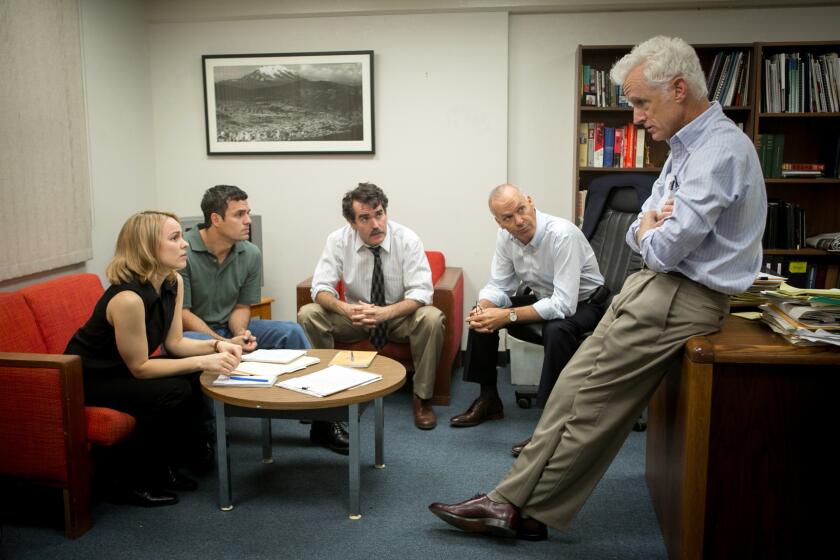California’s Inland Empire reels after losing hundreds of blue-collar jobs
Southern California is losing another manufacturing stalwart.
In two months, Ashley Furniture HomeStore will close two plants in Colton and lay off about 840 workers. The company said it would transfer the San Bernardino County production to its facilities in Wisconsin and North Carolina, citing the need to “create more efficiency.”
The move is a sign of the pressure bearing down on manufacturers in California and across the country, even as the sector recoups a chunk of the jobs it shed during the recession.
The Inland Empire, one of California’s poorest regions, has enjoyed a micro-boom in manufacturing employment, which has increased 15% since 2010. The region, which includes Riverside and San Bernardino counties, also has been buoyed in recent years by retail giant Amazon, which has leased massive warehouses that require packagers and truckers to transport those packages.
On Monday, home-shopping retailer QVC opened a 1-million-square-foot distribution facility in Ontario that will eventually employ 1,000 people.
But some economists and lawmakers worry that new labor rules and environmental regulations may be easier on tech companies in Silicon Valley than blue-collar employers in San Bernardino.
“It’s going to devastate our community. Eight hundred and forty families will be without sustenance,” said Cheryl R. Brown, the Democratic assemblywoman who represents San Bernardino. “If we want business in California, then we need to be welcoming to business. It needs to be not just one kind of business.”
Distribution and heavy manufacturing economies tend to be dirty, but they also offer people without much education a shot at a middle-class life.
People making furniture in California make an average of $43,319 per year, more than the $30,634 that warehouse workers take home. A job that pays the state’s minimum of $10 per hour equates to annual pay of $20,800.
Manufacturers still employ a lot of Californians, but, like in the rest of the country, their ranks have dwindled in recent years.
In 2015, the state was home to about 1.3 million manufacturing workers, which is about 215,000 less than there were in 2005, according to the Bureau of Labor Statistics.
That decline of 14% in California is slightly faster than the overall drop in U.S. manufacturing workers during that period.
Furniture makers have been in an even more dramatic tailspin. Last year, there were 1,961 furniture manufacturers in the state, down 33% since 2005. Employment has plunged to less than 34,700 compared with nearly 60,000 workers a decade ago.
“California is essentially eliminating its blue-collar sectors,” said John Husing, chief economist for the Inland Empire Economic Partnership. He called Ashley’s move “a gigantic blow” for the region.
Ashley executives did not offer a detailed explanation for their move, beyond saying in an email that it “strengthens production capability and cost structure and will help ensure Ashley’s continued ability to compete effectively long-term in the global marketplace from a U.S. base.”
Brown, the assemblywoman, said she toured Ashley’s Colton facilities two years ago and heard from company representatives that they were preoccupied with state “taxes [and] environmental concerns.”
Executives said they “were having issues with their trucks,” which have to meet strict state emissions standards, Brown said.
A law calling for deeper cuts to greenhouse gases, passed last week by the Assembly, would undermine the very industries that have powered San Bernardino’s economy, contends Husing, the economist.
“What [California regulations] have done is reduce the growth of jobs that allow people to move out of poverty toward the middle class,” Husing said.
And yet the state continues to grow much faster than the rest of the country. California has added more than 2 million jobs in the last six years and continues to outpace the nation in employment growth.
“Companies come and go all the time…. Long term, this means nothing,” said Chris Thornberg, the founding partner of Beacon Economics, a consulting firm in Los Angeles.
Thornberg noted that the Inland Empire specifically has been “an economic machine” in the last several years.
Unemployment in San Bernardino County was 6.7% in July, compared with 10.5% three years ago.
Gov. Jerry Brown, for his part, does not seem too concerned about losing a corporation here or there. In response to a question about the potential job cuts that would come from the state’s new greenhouse gas bill, which he has vowed to sign. Brown on Wednesday downplayed the risk of scaring off businesses.
“California’s economy is one of the most dynamic in America, and we have more regulation, we have a very healthy tax system,” the governor said, “and still they come.”
Follow me @NatalieKitro on Twitter
ALSO
Energy storage is taking on a greater role in the power grid. But how big can it get?
Mylan to launch a cheaper, generic version of EpiPen
American Airlines president jumps to a top spot at rival United







